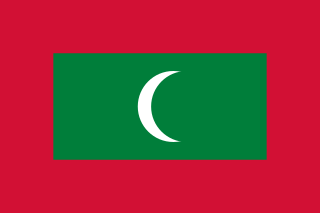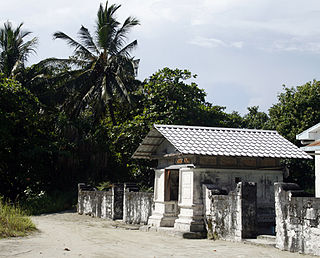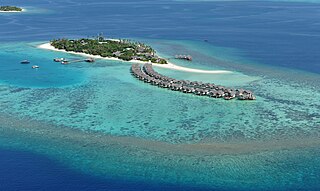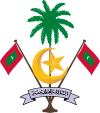
The Maldives, officially the Republic of Maldives, and historically known as the Maldive Islands, is a country and archipelagic state in South Asia in the Indian Ocean. The Maldives is southwest of Sri Lanka and India, about 750 kilometres from the Asian continent's mainland. The Maldives' chain of 26 atolls stretches across the equator from Ihavandhippolhu Atoll in the north to Addu Atoll in the south.

The history of the Maldives is intertwined with the history of the broader Indian subcontinent and the surrounding regions, comprising the areas of South Asia and the Indian Ocean. The modern nation is formed of 26 natural atolls, comprising 1194 islands. Historically, the Maldives has held strategic importance due to its location on the major marine routes of the Indian Ocean. The Maldives's nearest neighbors are the British Indian Ocean Territory, Sri Lanka and India. The United Kingdom, Sri Lanka, and some Indian kingdoms have had cultural and economic ties with the Maldives for centuries. In addition to these countries, Maldivians also traded with Aceh and many other kingdoms in what is today Indonesia and Malaysia. The Maldives provided the primary source of cowrie shells, which were then used as currency throughout Asia and parts of the East African coast. Most likely, the Maldives were influenced by the Kalingas of ancient India. The Kalingas were the earliest region of India to trade with Sri Lanka and the Maldives and were responsible for the spread of Buddhism. Stashes of Chinese crockery found buried in various locations in the Maldives also show that there was direct or indirect trade contact between China and the Maldives. In 1411 and 1430, the Chinese admiral Zheng He (鄭和) visited the Maldives. The Chinese also became the first country to establish a diplomatic office in the Maldives when the Chinese nationalist government based in Taipei opened an embassy in Malé in 1966. The Embassy of the People's Republic of China has since replaced this office.
As-Sulṭaan al-Ghaazee Muhammad Thakurufaanu al-A'uẓam or As-Sultan Ghazi Muhammad Bodu Thakurufaanu ruled over the Maldives Islands from 1573 to 1585. He is known for fighting the Portuguese who ruled over the Maldives from 1558–1573 after killing Sultan Ali VI in Malé. His victory is commemorated in the Maldives as Qaumee Dhuvas or National Day. He was also the first Maldivian Sultan to form a Lashkaru. He is regarded as a national hero.

Islam is the state religion of Maldives. The 2008 Constitution or "Fehi Gānoon" declares the significance of Islamic law in the country. The constitution requires that citizenship status be based on adherence to the state religion, which legally makes the country's citizens 100% Muslim.
Dhanbidhoo or Dambidū is one of the inhabited islands of Haddummati Atoll, administrative code Laamu.

Kudahuvadhoo is one of the inhabited islands of Dhaalu Atoll in the Maldives. It is also the capital of Dhaalu Atoll.

Dhives Akuru, later called Dhivehi Akuru is a script formerly used for the Maldivian language. The name can be alternatively spelled Dives Akuru or Divehi Akuru using the ISO 15919 Romanization scheme, as the "d" is unaspirated.
Several Dhivehi scripts have been used by Maldivians during their history. The early Dhivehi scripts fell into the abugida category, while the more recent Thaana has characteristics of both an abugida and a true alphabet. An ancient form of Nagari script, as well as the Arabic and Devanagari scripts, have also been extensively used in the Maldives, but with a more restricted function. Latin was official only during a very brief period of the Islands' history.

The Istanbul Archaeology Museums are a group of three archaeological museums located in the Eminönü quarter of Istanbul, Turkey, near Gülhane Park and Topkapı Palace. These museums house over one million objects from nearly all periods and civilizations in world history.

Hinduism in the Maldives describes the practice of the Hindu religion in the Maldives archipelago. Evidence suggests that Hinduism had a presence in the ancient Maldives. Hinduism may have marginally existed during the Buddhist period of the islands but disappeared sometime later during that same period. Traces of its influences are still found in modern Maldivian culture and art.

The National Museum of Pakistan is a public museum located in Karachi, Pakistan.
Maldivian mythology or Maldivian folklore is the body of myths, tales and anecdotes belonging to the oral tradition of Maldivians. Even though some of the Maldivian myths were already mentioned briefly by British commissioner in Ceylon HCP Bell towards the end of the 19th century, their study and publication were carried out only quite recently by Spanish writer and artist Xavier Romero-Frias, at a time when that ancestral worldview was quickly disappearing.

Laamu Atoll, historically known as Haddhunmathi Atoll, is an administrative division of the Maldives. The administrative capital is Fonadhoo Island. It corresponds to the natural atoll of the same name. It is mostly rimmed by barrier reefs, the broadest of which are topped by islands. There are many islands along its eastern and southern boundaries. This atoll is quite regular excepting for the projection of the reef at its NE corner. It closely resembles Kolhumadulhu, its neighbour further north. Owing to its typical atoll shape, it differs in no respect from atolls in the Pacific Ocean, save for its greater size. Its reefs are generally of little breadth, with no signs of vilu, except for its eastern fringes which are covered with islands that are quite large by Maldivian standards. The lagoon is comparatively open, containing scattered shoal patches; the bottom is muddy and the average depth is from 30 to 34 fathoms.

Buddhism was the predominant religion in the Maldives until at least the 12th century CE. It isn't clear how and when Buddhism was introduced into the islands.

The Malé Friday Mosque, also known as the Malé Hukuru Miskiy, or the Old Friday Mosque, is a Sufism Sunni Islam mosque, located in the city of Malé, Kaafu Atoll, Maldives.

Maldivians are an Indo-Aryan ethnic group and nation native to the historic region of the Maldive Islands, present day Republic of Maldives and the island of Minicoy in Union Territory of Lakshadweep, India. Maldivians share one culture and speak the Dhivehi language, which is a member of the southern group of Indo-Aryan languages. For ethnographic and linguistic purposes as well as geopolitical reasons, anthropologists divide the Maldivian people into three subgroups.

Maamigili is one of the uninhabited islands of Raa Atoll in the Maldives. The island measures 750 meters in length and 500 meters in width for 100 hectares of coral reef.

The Nasser D. Khalili Collection of Islamic Art includes 26,000 objects documenting Islamic art over a period of almost 1400 years, from 700 AD to the end of the twentieth century. It is the largest of the Khalili Collections: eight collections assembled, conserved, published and exhibited by the British scholar, collector and philanthropist Nasser David Khalili, each of which is considered among the most important in its field. Khalili's collection is one of the most comprehensive Islamic art collections in the world and the largest in private hands.

The Sultanate of the Maldive Islands was an Islamic monarchy that controlled the Maldives for 815 years (1153–1968), with one interruption from 1953–1954.

















































